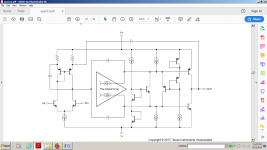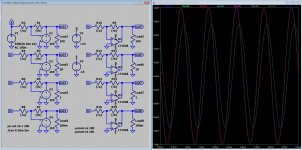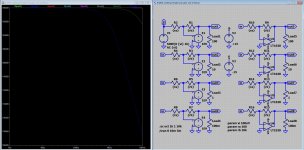O.k. that was one halve of the (wild) idea  , I did realize that the output signal is small (very) but the loading may have an positive effect because you are (in effect) selecting positive or negative drive of the output stage (and that may make a difference). Emitter followers can be influenced from the 'outside' easily. [This depends (of course) on the internal construction of the opamp]
, I did realize that the output signal is small (very) but the loading may have an positive effect because you are (in effect) selecting positive or negative drive of the output stage (and that may make a difference). Emitter followers can be influenced from the 'outside' easily. [This depends (of course) on the internal construction of the opamp]
The other point is, when the output signal level is small then loading the output may influence the GBW of the first opamp (I'm thinking to load it with 10 Ohm or even lower, even at 1 Ohm a 1mA output signal generates little current [as we know], you could possibly go as low as 100 mOhm). This in return may change to oscillatory behavior of the composite.
Any way, this caught may attention and I find it interesting.
PS: Also, a low resistive load may make the diodes redundant.
The other point is, when the output signal level is small then loading the output may influence the GBW of the first opamp (I'm thinking to load it with 10 Ohm or even lower, even at 1 Ohm a 1mA output signal generates little current [as we know], you could possibly go as low as 100 mOhm). This in return may change to oscillatory behavior of the composite.
Any way, this caught may attention and I find it interesting.
PS: Also, a low resistive load may make the diodes redundant.
Last edited:
i can't see any emitter follower in opa211 datasheet...Emitter followers can be influenced from the 'outside' easily. [This depends (of course) on the internal construction of the opamp]
you can't load the first op-amp because of the second one...and if you want it loaded you don't need the second op-amp anyway...you just load it and buffer it with anything.
Attachments
i can't see any emitter follower in opa211 datasheet...
You are right, I was stupid enough to post the idea not checking the datasheet
you can't load the first op-amp because of the second one...and if you want it loaded you don't need the second op-amp anyway...you just load it and buffer it with anything.
You can load the first, because you have a ground(reference) connection on the composite.
If someone(anyone) has a copy of the original article (other than the expensive book) then please tell us(me).
The only source (for the article) I could find was:
Low-Distortion, Low-Noise Composite Operational Amplifier
And if I did pay for any item(pdf or book) I was interested in, then I would not be the rich person I'm now
I can't see a single reason why you'd do this to a circuit that works perfectly this way...use valves instead!
...
Because (like any other circuit) it has specific problems and there may be ways to improve (the circuit) it's behavior (in the situation that you are using it). But, first you say it is not posible, and now you say it is not wanted, why (rhetorical)?
One reason you may want to load the output is to prevent oscillation (witch this type of circuit easily does). First of all a resistor is cheaper than 4 diodes and it may be easier to implement (less space needed) and the layout of the circuit (on PCB) may be improved, and there are less components in the feedback path, and the feedback path get smaller (less capacity and less inductance). There may be more reasons for modifying the schematic, but these came just of the top of my head.
....use valves instead!
...
Or are you trying to be offensive (rhetorical)? Any way, if so, then I am gone.
If someone(anyone) has a copy of the original article (other than the expensive book) then please tell us(me).
The only source (for the article) I could find was:
Low-Distortion, Low-Noise Composite Operational Amplifier
And if I did pay for any item(pdf or book) I was interested in, then I would not be the rich person I'm now
You can get it from AES, by paying for it like everyone else did.
You can pursue your idea, but it’s probably not going to improve anything.
Honestly, AES-subscription is not that expensive at all. It is 100 euro a year, for that you get a near unlimited amount of papers about audio, trainings and discount for certain exhibitions.
I can understand that you don't buy every book available as some super technical books are super expensive (200$+), but wanting everything for free seems quite unrealistic and unethical.
To be honest I think that if you want to get the knowledge you should invest in it by spending either money (buying subscription) or spending time (design your own op-amp).
I can understand that you don't buy every book available as some super technical books are super expensive (200$+), but wanting everything for free seems quite unrealistic and unethical.
To be honest I think that if you want to get the knowledge you should invest in it by spending either money (buying subscription) or spending time (design your own op-amp).
You can pursue your idea, but it’s probably ...
Is it not the 'probably/probability' that we are discussing here?
Unrealistic...yes, unethical...Hell NO!, but wanting everything for free seems quite unrealistic and unethical.
.
I want everything for free...
Unrealistic...yes, unethical...Hell NO!
I want everything for free...
Really, what a simple question is bringing about, I just wanted to know if someone had something (maybe even Samuel G) that could be added to this thread, something that would enrich the thread for everyone.
After 40 years (more than) using forums, bulletin boards and even Kermit, not to forget news groups and other publishing appliances, I'm amazed what people do ask in response to a simple question. No I am not asking anyone to illegally publish anything (I was just asking).
Low-Distortion, Low-Noise Composite Operational Amplifier - Semantic Scholar just hit the view paper button
Thank you Man!Low-Distortion, Low-Noise Composite Operational Amplifier - Semantic Scholar just hit the view paper button
As long as the electrons can move freely everywhere in nature and nobody is owning one single electron in the whole universe, an electronics engineer should be the first to show his contempt to the establishment of this narrow minded world we are living in and condemn "private or intelectual property" too.
Last edited:
Loading the first op-amp's output with a 1 ohm resistor will cost you lots of loopgain, no matter whether it has an emitter follower or a Monticelli output stage, because the open-loop output impedance will in either case be well above 1 ohm. When you reduce loopgain, you will also have to redesign the frequency compensation.
Only V(out8) has it's loop-gain changed by loading (it seems). When studying it better you will realize that the lowered output voltage is due to the output impedance of the amplifier.
Attachments
Re: opamp rolling: read the paper, especially the stuff about the compensation of such a combo. Then ask yourself: am I experienced/knowledgable enough to have figured that all out by myself? Unless the answer is 'definitely', don't roll the opamps. Just build it. Unless you are in SM ;-)
Jan
Jan
- Home
- Source & Line
- Analog Line Level
- Samuel Groner's super opamp



